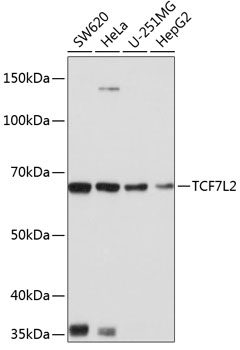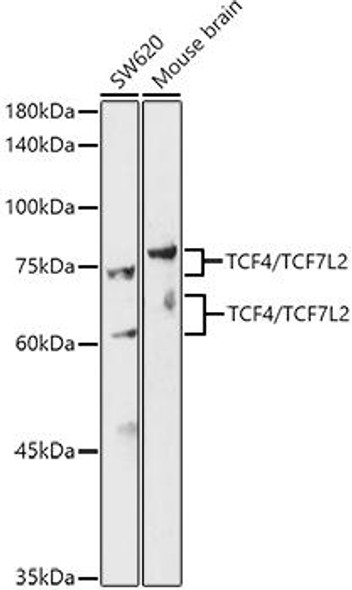Cell Biology Antibodies 15
Anti-TCF7L2 Antibody (CAB19548)
- SKU:
- CAB19548
- Product Type:
- Antibody
- Reactivity:
- Human
- Reactivity:
- Mouse
- Reactivity:
- Rat
- Host Species:
- Rabbit
- Isotype:
- IgG
- Research Area:
- Cell Biology
Description
| Antibody Name: | Anti-TCF7L2 Antibody |
| Antibody SKU: | CAB19548 |
| Antibody Size: | 20uL, 50uL, 100uL |
| Application: | WB IHC |
| Reactivity: | Human, Mouse, Rat |
| Host Species: | Rabbit |
| Immunogen: | A synthesized peptide derived from human TCF7L2. |
| Application: | WB IHC |
| Recommended Dilution: | WB 1:500 - 1:2000 IHC 1:50 - 1:200 |
| Reactivity: | Human, Mouse, Rat |
| Positive Samples: | SW620, HeLa, U-251MG, HepG2 |
| Immunogen: | A synthesized peptide derived from human TCF7L2. |
| Purification Method: | Affinity purification |
| Storage Buffer: | Store at -20°C. Avoid freeze / thaw cycles. Buffer: PBS with 0.02% sodium azide, 0.05% BSA, 50% glycerol, pH7.3. |
| Isotype: | IgG |
| Sequence: | Email for sequence |
| Gene ID: | 6934 |
| Uniprot: | Q9NQB0 |
| Cellular Location: | |
| Calculated MW: | 68kDa |
| Observed MW: | 68KDa |
| Synonyms: | TCF-4, TCF4, TCF7L2 |
| Background: | This gene encodes a high mobility group (HMG) box-containing transcription factor that plays a key role in the Wnt signaling pathway. The protein has been implicated in blood glucose homeostasis. Genetic variants of this gene are associated with increased risk of type 2 diabetes. Several transcript variants encoding multiple different isoforms have been found for this gene.[provided by RefSeq, Oct 2010] |
| UniProt Protein Function: | TCF7L2: Participates in the Wnt signaling pathway and modulates MYC expression by binding to its promoter in a sequence-specific manner. Acts as repressor in the absence of CTNNB1, and as activator in its presence. Activates transcription from promoters with several copies of the Tcf motif 5'-CCTTTGATC-3' in the presence of CTNNB1. TLE1, TLE2, TLE3 and TLE4 repress transactivation mediated by TCF7L2/TCF4 and CTNNB1. Expression of dominant-negative mutants results in cell-cycle arrest in G1. Necessary for the maintenance of the epithelial stem-cell compartment of the small intestine. Interacts with TGFB1I1. Interacts with CTNNB1 (via the armadillo repeat); forms stable transcription complex. Interacts with EP300. Interacts with NLK. Interacts with CCDC85B (probably through the HMG box); prevents interaction with CTNNB1. Interacts with TNIK. Interacts with MAD2L2; prevents TCF7L2/TCF4 binding to promZIPK/DAPK3oters, negatively modulating its transcriptional activity. Interacts with ZIPK/DAPK3. Interacts with XIAP/BIRC4 and TLE3. Detected in epithelium from small intestine, with the highest expression at the top of the crypts and a gradient of expression from crypt to villus. Detected in colon epithelium and colon cancer, and in epithelium from mammary gland and carcinomas derived therefrom. Belongs to the TCF/LEF family. 10 isoforms of the human protein are produced by alternative splicing. |
| UniProt Protein Details: | Protein type:Apoptosis; Motility/polarity/chemotaxis; DNA-binding; Transcription factor; Cell development/differentiation; Cell cycle regulation Chromosomal Location of Human Ortholog: 10q25.3 Cellular Component: nucleoplasm; transcription factor complex; PML body; cytoplasm; nuclear chromatin; nucleus Molecular Function:protein binding; sequence-specific DNA binding; gamma-catenin binding; beta-catenin binding; chromatin binding; transcription factor binding; transcription factor activity; protein kinase binding; nuclear hormone receptor binding Biological Process: neural tube development; skin development; glycogen metabolic process; fat cell differentiation; regulation of myelination; somatic stem cell maintenance; positive regulation of apoptosis; Wnt receptor signaling pathway through beta-catenin; glucose homeostasis; maintenance of DNA repeat elements; negative regulation of BMP signaling pathway; post-embryonic development; embryonic digestive tract morphogenesis; response to glucose stimulus; cell cycle arrest; oligodendrocyte development; embryonic hindgut morphogenesis; embryonic genitalia morphogenesis; regulation of hormone metabolic process; transcription, DNA-dependent; regulation of smooth muscle cell proliferation; negative regulation of transcription factor activity; glucose metabolic process; positive regulation of insulin secretion; cellular response to starvation; negative regulation of organ growth; negative regulation of fat cell differentiation; regulation of transcription from RNA polymerase II promoter; positive regulation of transcription from RNA polymerase II promoter; negative regulation of transcription, DNA-dependent; positive regulation of epithelial cell proliferation; secretory granule localization; myoblast cell fate commitment; positive regulation of protein binding; negative regulation of fibroblast growth factor receptor signaling pathway; regulation of oligodendrocyte differentiation; negative regulation of transcription from RNA polymerase II promoter; bone mineralization; positive regulation of protein export from nucleus; positive regulation of gluconeogenesis; pancreas development; blood vessel development; multicellular organism growth; odontogenesis of dentine-containing teeth; positive regulation of protein kinase B signaling cascade; cell proliferation; generation of neurons; pituitary gland development; regulation of skeletal muscle development; brain development Disease: Diabetes Mellitus, Noninsulin-dependent |
| NCBI Summary: | This gene encodes a high mobility group (HMG) box-containing transcription factor that plays a key role in the Wnt signaling pathway. The protein has been implicated in blood glucose homeostasis. Genetic variants of this gene are associated with increased risk of type 2 diabetes. Several transcript variants encoding multiple different isoforms have been found for this gene.[provided by RefSeq, Oct 2010] |
| UniProt Code: | Q9NQB0 |
| NCBI GenInfo Identifier: | 29337146 |
| NCBI Gene ID: | 6934 |
| NCBI Accession: | Q9NQB0.2 |
| UniProt Secondary Accession: | Q9NQB0,B4DRJ8, B9X074, C6ZRJ8, C6ZRK0, E2GH14, E2GH19 E2GH20, E2GH24, E2GH25, E9PFH9, F8W742, |
| UniProt Related Accession: | Q9NQB0 |
| Molecular Weight: | 619 |
| NCBI Full Name: | Transcription factor 7-like 2 |
| NCBI Synonym Full Names: | transcription factor 7-like 2 (T-cell specific, HMG-box) |
| NCBI Official Symbol: | TCF7L2 |
| NCBI Official Synonym Symbols: | TCF4; TCF-4 |
| NCBI Protein Information: | transcription factor 7-like 2; hTCF-4; T-cell factor 4; T-cell factor-4 variant A; T-cell factor-4 variant B; T-cell factor-4 variant C; T-cell factor-4 variant D; T-cell factor-4 variant E; T-cell factor-4 variant F; T-cell factor-4 variant G; T-cell fac |
| UniProt Protein Name: | Transcription factor 7-like 2 |
| UniProt Synonym Protein Names: | HMG box transcription factor 4; T-cell-specific transcription factor 4; T-cell factor 4; TCF-4; hTCF-4 |
| Protein Family: | Transcription factor |
| UniProt Gene Name: | TCF7L2 |
| UniProt Entry Name: | TF7L2_HUMAN |







